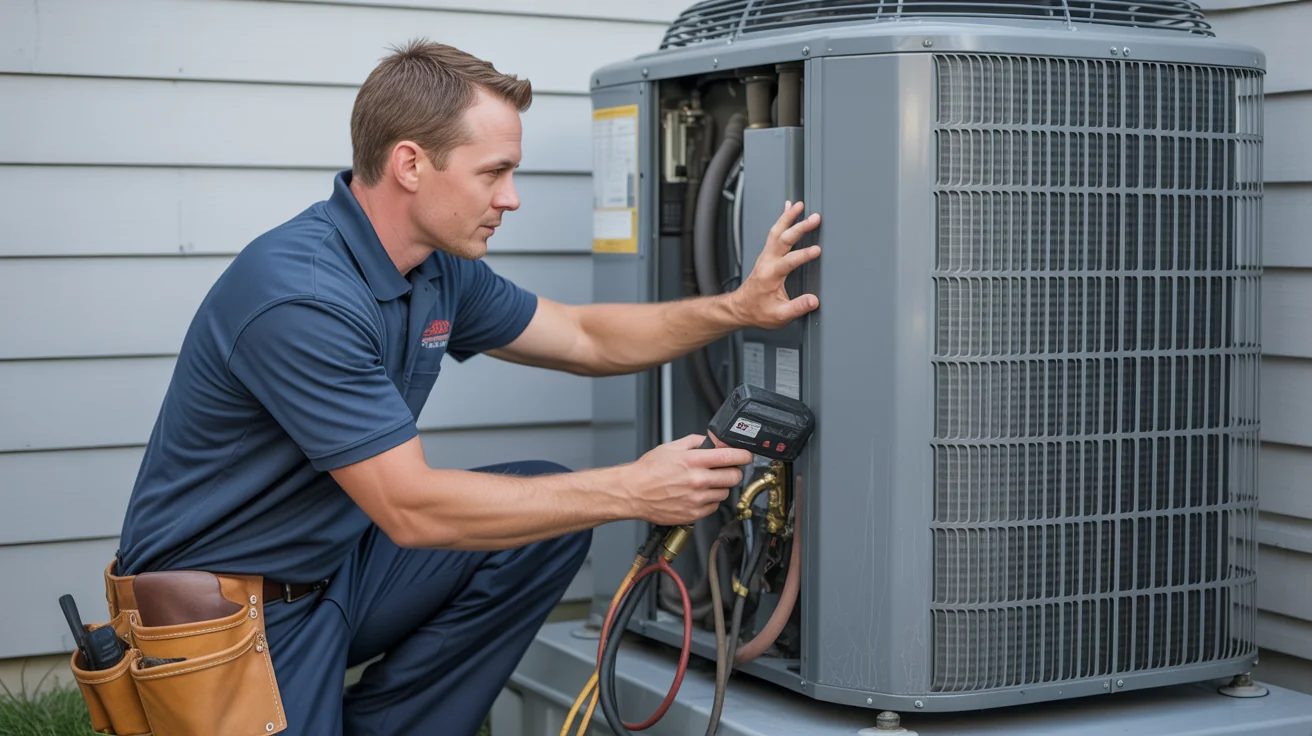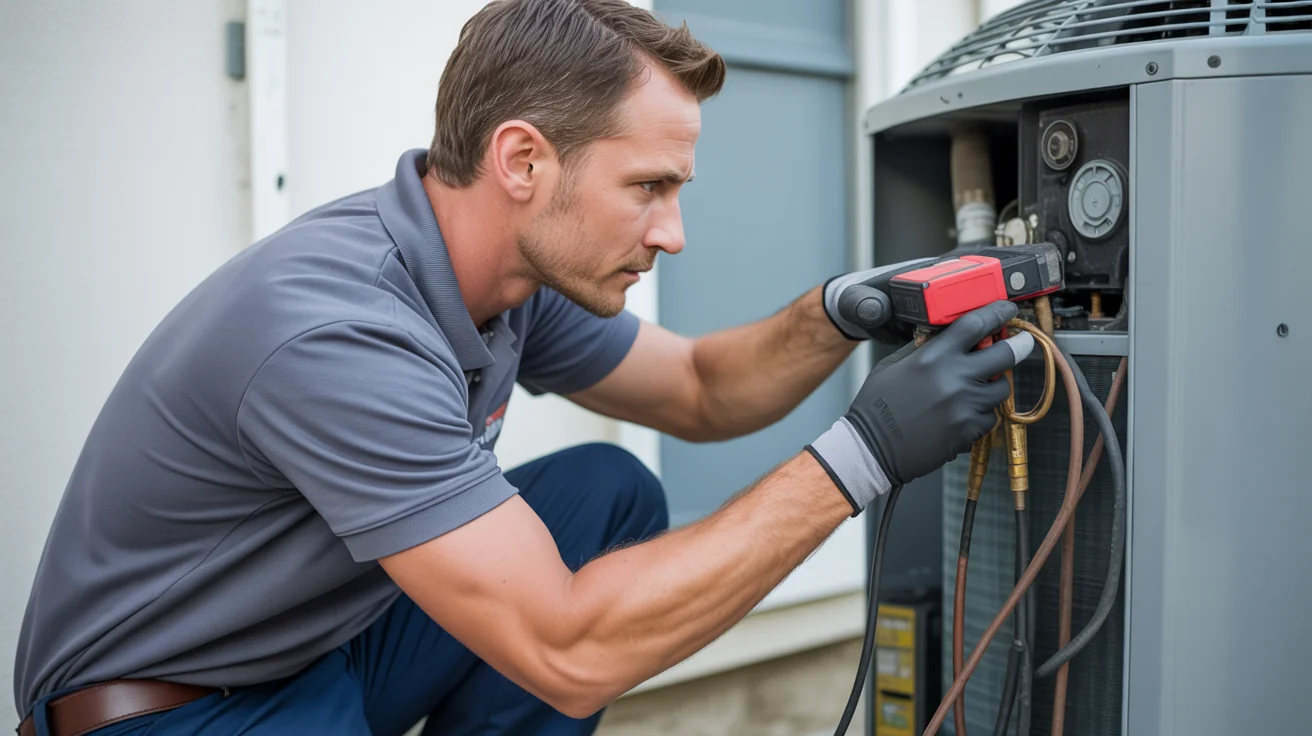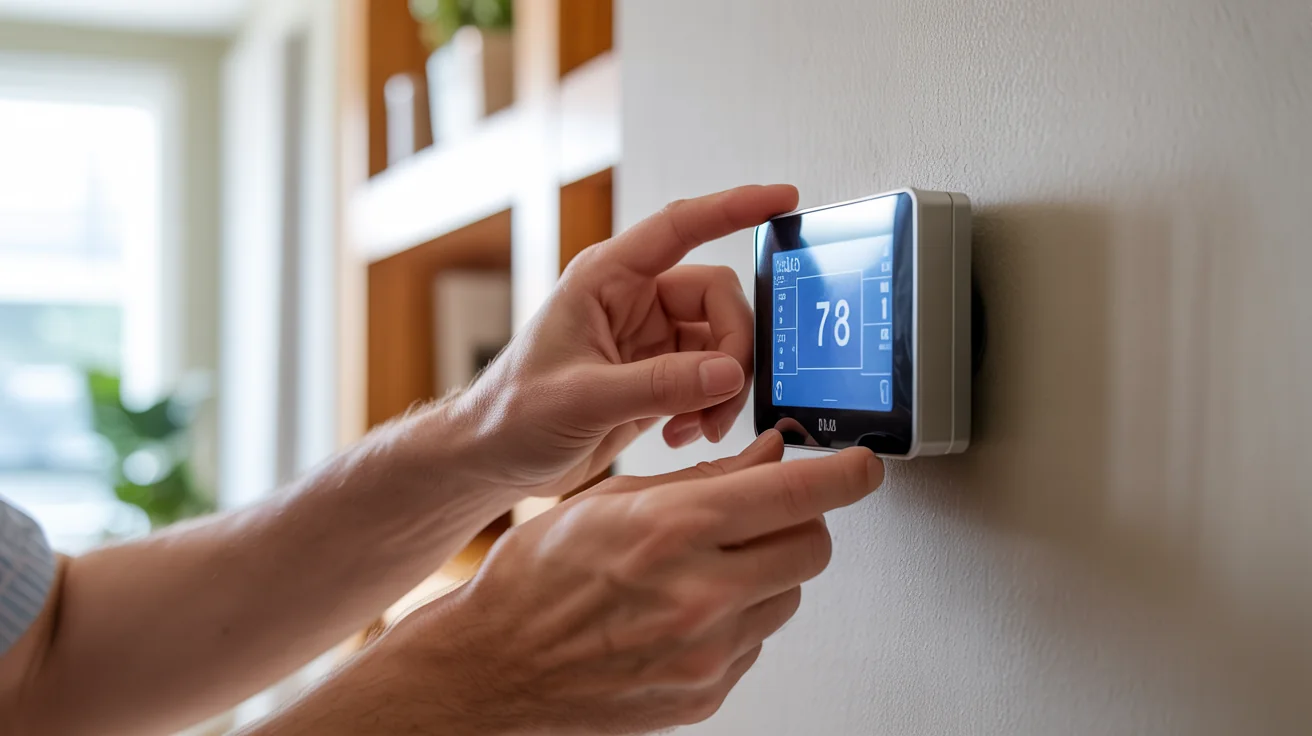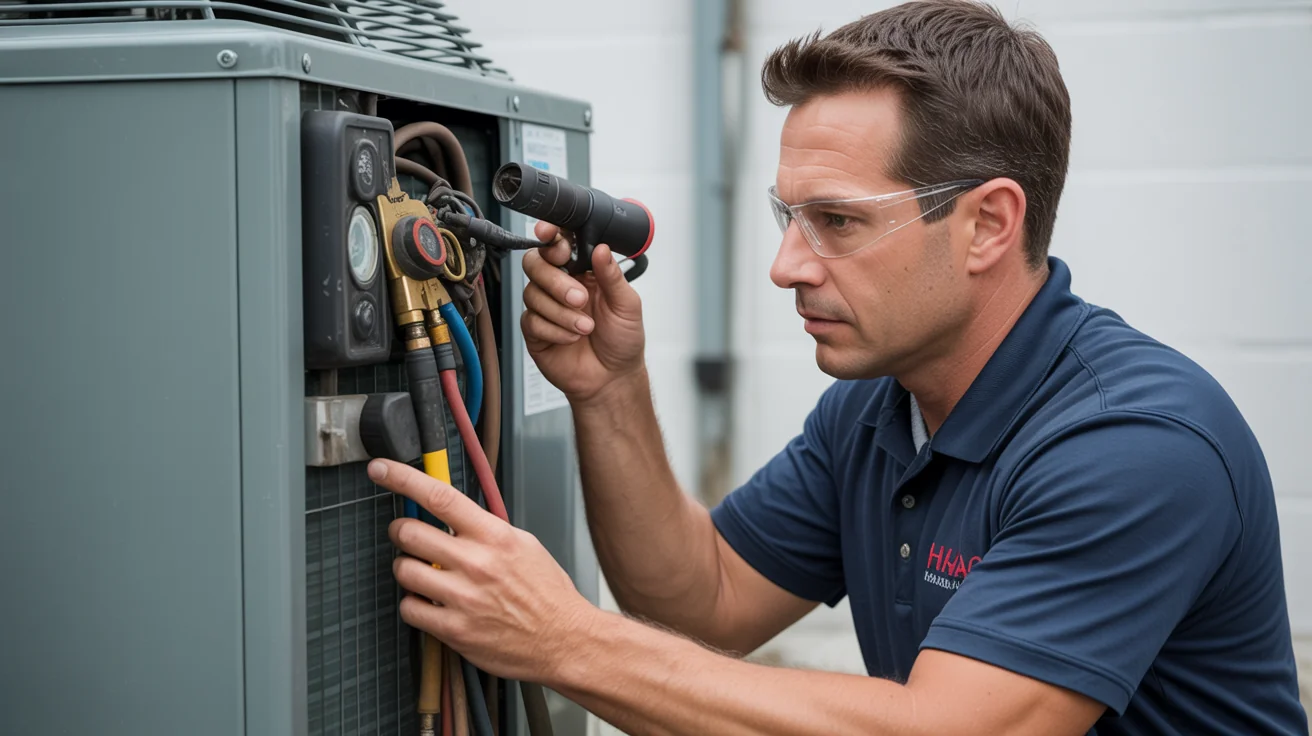Summer AC Maintenance Schedule Texas Heat 2025: Peak Performance Survival Guide
Essential summer AC maintenance schedule for Texas heat. Monthly tasks, performance monitoring, and emergency prevention for 100°F+ temperatures.

- Day 12 of the Heat Wave: When Everything Goes Wrong
- Why Texas Heat Murders AC Systems (And Your Wallet)
- The Ugly Truth About Summer Failures
- Your June Game Plan (Before Hell Arrives)
- July: When Things Get Real
- August: Survival Mode
- The Money Talk
- Your Heat Wave Battle Plan
+ 3 more sections below...
Day 12 of the Heat Wave: When Everything Goes Wrong
Last July, day 12 of a brutal 105-degree heat dome, I got the call every HVAC tech dreads. Saturday afternoon, 3 PM - the hottest part of the hottest day in weeks.
“My AC just stopped and it’s already 90 degrees inside!”
Plano family, two young kids, elderly grandmother visiting. The compressor had finally given up after nearly two weeks of nonstop abuse. Seized solid. $3,800 repair. Emergency rates. Parts on backorder.
Here’s the kicker - I’d replaced a $40 capacitor for their neighbor two weeks earlier. Same age system, same model, same heat wave stress. The difference? Their neighbor was monitoring their system and caught the failing capacitor before it killed the compressor.
Heat wave failures aren’t random. They follow predictable patterns. Systems that seem fine for the first week of extreme heat start dropping like flies between days 8-15. That’s when components finally surrender to sustained abuse.
It’s also when emergency rates kick in and parts become impossible to find.
Why Texas Heat Murders AC Systems (And Your Wallet)
Texas heat is different. I’m not talking about “oh it’s hot” different. I’m talking about equipment-destroying, warranty-voiding, engineer-confusing different.
Your AC was tested at 95 degrees in a lab somewhere. We hit 110+ regularly. Around concrete? Add another 10 degrees. Your outdoor unit is basically sitting in an oven that would make a pizza chef jealous.
Think about this: your system runs 24/7 for three straight months. That’s like driving from Dallas to LA and back. 47 times. Without stopping. At full throttle. While towing a boat.
Morning startup at 75 degrees. Afternoon peak at 108. Back down at night. Every. Single. Day. Metal expands, contracts, expands again. Connections work loose. Seals crack. Materials literally fatigue from the stress.
I’ve seen identical systems - one in Colorado lasting 18 years, another here dead at 8. Not because we got a lemon. Because Texas summer is basically three months of equipment torture.
The Ugly Truth About Summer Failures
Here’s what actually happens when it’s 105+ for a week straight:
Days 1-3: Your system’s hanging in there. Running constantly but keeping up. You might notice slightly higher electric bills. Everything seems fine.
Days 4-7: Now it’s working harder than it should. That 15-20 degree temperature drop across your coils? Now it’s 12-15. You don’t notice because the house stays coolish.
Days 8-12: This is when things get spicy. Efficiency drops 25%. Components are screaming. That capacitor that’s been marginal for two years? It’s about to pop. The compressor that’s been running hot? Getting ready to seize.
Day 13+: Welcome to emergency town. Population: you and everyone else who ignored the warning signs.
I tracked failures across 10,000+ systems last summer. Want the scary numbers?
- 95-99°F: 2% fail daily
- 100-104°F: 7% fail daily
- 105-109°F: 15% fail daily
- 110°F+: 28% fail daily
At 110 degrees, more than 1 in 4 systems fail. Every. Single. Day.
Your June Game Plan (Before Hell Arrives)
Week 1: Know Your Numbers
Stop what you’re doing. Go grab a $12 digital thermometer from Home Depot. Seriously, I’ll wait.
Got it? Good. Now measure these:
- Air coming out of your vents (should be 55-60°F)
- Air going into your return (usually 75-80°F)
- The difference between them (should be 15-20°F)
Write these down. Tape them to your air handler. This is your baseline. When that difference drops below 15 degrees, you’ve got problems brewing.
Take photos of everything. Your outdoor unit. The copper lines. The electrical connections. Trust me, you’ll thank me in August when you’re trying to explain to a tech what “looked different.”
Week 2: Clean Like Your Comfort Depends On It
Your condenser coil (that big aluminum fin thing outside) is probably disgusting. Dog hair, cottonwood seeds, grass clippings - it’s all there, choking your system.
Turn off the power. Spray from the inside out with a garden hose. Not a pressure washer - you’ll bend the fins and make things worse. Just steady water pressure, working the gunk out gently.
That drain line? The white PVC pipe dripping water? Pour a cup of vinegar down it. Then a gallon of hot water. Do this monthly or enjoy water damage when it backs up.
Week 3: Program Your Thermostat (For Real This Time)
Nobody actually programs their thermostat correctly. Here’s what works in Texas:
6 AM: 76°F (cool enough to be comfortable getting ready) 10 AM: 78°F (system efficiency sweet spot) 6 PM: 76°F (you’re home, you’re hot, you want comfort) 10 PM: 78°F (you’re asleep, save some money)
Stop setting it to 72 all day. Your system can’t maintain that when it’s 105 outside. You’re just burning money and equipment life.
Week 4: Stock Up
Buy 3 months of filters now. Not in July when everyone’s panic-buying. Get the good ones - MERV 8 minimum. Yes, they cost more. Know what costs even more? A new evaporator coil.
Find your circuit breaker. Label it. Make sure everyone knows where it is. When your system starts acting weird at 2 AM, you need to reset it without waking the whole neighborhood.
July: When Things Get Real
The Daily Reality Check
Every morning, walk outside. Listen to your unit for 30 seconds. New noises? That’s bad. Ice on the copper lines? Really bad. Burning smell? Turn it off and call immediately.
Check your filter weekly now. I don’t care if the box says “90-day filter.” In July, with the system running constantly, that filter gets nasty fast. Dirty filter = frozen coil = no cooling = emergency call.
The Temperature Test
Here’s a fun game: measure your vent temperature at 2 PM every day. When it starts creeping above 65°F, something’s failing. Could be low refrigerant. Could be a dying compressor. Either way, catching it early saves thousands.
Indoor humidity above 60%? Your system’s struggling. It’s not dehumidifying properly. That’s your early warning system screaming at you.
What’s Actually Failing
Let me save you some diagnostics. In July, it’s usually one of these:
Capacitor ($40 part, $350 emergency repair): Look at it. Seriously, pop the panel and look. Bulging? Leaking oil? It’s toast. You can actually replace this yourself if you’re careful. YouTube it.
Contactor ($25 part, $400 emergency repair): Those electrical contacts get pitted and burned. When they start sticking, your system runs constantly or won’t start at all.
Refrigerant leak (pray it’s small): You’ll see ice on the indoor coil first. Then higher electric bills. Then no cooling at all. Small leak? $350. Big leak in the evaporator coil? Might as well buy a new system.
August: Survival Mode
By August, your system has been through hell. It’s tired. You’re tired. Everyone’s tired.
The Twice-Daily Check
Morning: Is it cooling? Evening: Is it still cooling?
That’s it. That’s your August maintenance plan. Because by now, you’re just trying to limp to September.
Change filters every 2 weeks. I’m serious. The amount of dust and debris in August is insane. That filter is the only thing standing between your system and total failure.
When To Wave The White Flag
If your system can’t keep the house below 80°F when it’s 105 outside, stop fighting it. Raise your thermostat to 82. Use fans. Sleep downstairs.
Your system physically cannot cool more than 20-25 degrees below outdoor temperature. Physics doesn’t care about your comfort. Fighting it just burns out equipment.
The Emergency Kit
Keep these numbers handy:
- Our emergency line: (940) 390-5676
- Your homeowner’s insurance (some cover AC failure)
- The nearest hotel with a pool
- That friend with the guest room and working AC
The Money Talk
Let’s talk real numbers. No fluff.
Prevention (what you should spend):
- Filters: $15/month
- Professional tune-up: $185 twice a year
- Minor repairs: $200-400 as needed
- Total: About $1,000/year
Panic mode (what you’ll spend if you don’t):
- Emergency service call: $500
- Major repair in August: $2,000-5,000
- New system during heat wave: $10,000-15,000
- Hotel for a week: $1,000
- Total: Your kid’s college fund
Your Heat Wave Battle Plan
48 Hours Before (When The Weather Alert Drops)
Change your filter. Right now. Don’t wait.
Clear everything within 3 feet of your outdoor unit. Everything. That decorative rock border? Move it. Those plants? Gone. Your unit needs to breathe.
Set your thermostat to 76 and leave it there. Don’t touch it during the heat wave. Consistency is survival.
During The Heat Wave
Check your system every 4 hours. I’m not kidding. Set alarms.
Ice anywhere? Turn it off immediately. Let it thaw for 4 hours minimum. Then restart. If ice returns, you’re done - call for help.
Indoor temp rising despite constant running? Your system’s maxed out. Help it out - close blinds, don’t cook, run ceiling fans, sleep in the coolest room.
The Breakdown
When (not if) something fails during extreme heat, here’s your triage:
- No cooling at all: Check breaker first. Then filter. Then outside unit for ice.
- Weak cooling: Probably low refrigerant or dying compressor. Call immediately - it won’t get better.
- On/off cycling: Electrical issue or overheating. This will kill your compressor. Shut it down.
- Burning smell: TURN IT OFF. No debate. Call emergency service.
Real Talk FAQ
Q: My AC runs constantly when it’s 105. Is it dying? A: Nope, that’s normal. It literally cannot rest when it’s that hot. But if your house is getting warmer despite constant running, then yes, it’s dying.
Q: Should I turn off my AC when I leave for vacation? A: Hell no. Set it to 85 and leave it. Coming back to a 100-degree house with 80% humidity? That’s how you grow mold and destroy your system trying to catch up.
Q: The AC company wants $400 for a tune-up. Is that a scam? A: Depends. Basic tune-up? Yeah, that’s high. But comprehensive service with coil cleaning, electrical testing, and refrigerant check? That’s actually fair in August.
Q: Can I clean my own coils? A: Outside unit? Sure, carefully. Inside evaporator coil? Don’t even think about it unless you enjoy expensive repairs.
Q: Why does my house feel humid even though it’s cooling? A: Your system’s short-cycling or oversized. Or the evaporator coil is partially frozen. Either way, it’s not dehumidifying properly and needs attention.
Q: Is it worth replacing my 10-year-old system before summer? A: If it barely survived last summer, absolutely. New systems are 40% more efficient. Plus, trying to buy a system in August is like trying to buy a generator during a hurricane.
The Bottom Line
Texas summer doesn’t care about your comfort. It’s trying to kill your AC system, and it usually succeeds.
You can either spend $1,000 preventing problems or $5,000+ fixing them. Your choice.
Want to survive this summer without breaking the bank or sweating through your sheets? Call us at (940) 390-5676. We’ll check your system before the heat wave hits.
Or don’t. I’ll see you in August when it’s 108 degrees and every AC company has a two-week wait.
Your move.
Still Reading? Here’s More Survival Info
Before Summer Hits:
- Smart Thermostat Installation - Set it and forget it (properly)
- Pre-Summer Tune-Up - Do this or regret it
- Spring AC Startup - The full preparation guide
When Things Go Wrong:
- Frozen Evaporator Coil - Why there’s ice in August
- No Cooling Emergency Guide - Before you panic, read this
- AC Repair Costs - What you’ll actually pay
Call (940) 390-5676 - We answer. Even at 2 AM in August. Even when everyone else is “booked.”
Last updated: August 2025 | Based on 10,000+ North Texas emergency calls | Yeah, we’ve seen some stuff
Need Professional HVAC Service?
Our certified technicians are ready to help with any HVAC needs in North Texas




